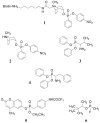Routes to covalent catalysis by reactive selection for nascent protein nucleophiles
- PMID: 18044899
- PMCID: PMC2527816
- DOI: 10.1021/ja076528m
Routes to covalent catalysis by reactive selection for nascent protein nucleophiles
Abstract
Reactivity-based selection strategies have been used to enrich combinatorial libraries for encoded biocatalysts having revised substrate specificity or altered catalytic activity. This approach can also assist in artificial evolution of enzyme catalysis from protein templates without bias for predefined catalytic sites. The prevalence of covalent intermediates in enzymatic mechanisms suggests the universal utility of the covalent complex as the basis for selection. Covalent selection by phosphonate ester exchange was applied to a phage display library of antibody variable fragments (scFv) to sample the scope and mechanism of chemical reactivity in a naive molecular library. Selected scFv segregated into structurally related covalent and noncovalent binders. Clones that reacted covalently utilized tyrosine residues exclusively as the nucleophile. Two motifs were identified by structural analysis, recruiting distinct Tyr residues of the light chain. Most clones employed Tyr32 in CDR-L1, whereas a unique clone (A.17) reacted at Tyr36 in FR-L2. Enhanced phosphonylation kinetics and modest amidase activity of A.17 suggested a primitive catalytic site. Covalent selection may thus provide access to protein molecules that approximate an early apparatus for covalent catalysis.
Figures





References
-
- Fernandez-Gacio A, Uguen M, Fastrez J. Trends in Biotechnology. 2003;21:408–414. - PubMed
-
- Soumillion P, Fastrez J. Curr Opin Biotechnol. 2001;12:387–394. - PubMed
-
- Powers JC, Asgian JL, Ekici OD, James KE. Chem Rev. 2002;102:4639–4750. - PubMed
-
- Danielsen S, Eklund M, Deussen HJ, Graslund T, Nygren PA, Borchert TV. Gene. 2001;272:267–274. - PubMed
-
- Legendre D, Laraki N, Graslund T, Bjornvad ME, Bouchet M, Nygren PA, Borchert TV, Fastrez J. J Mol Biol. 2000;296:87–102. - PubMed
Publication types
MeSH terms
Substances
Grants and funding
LinkOut - more resources
Full Text Sources

